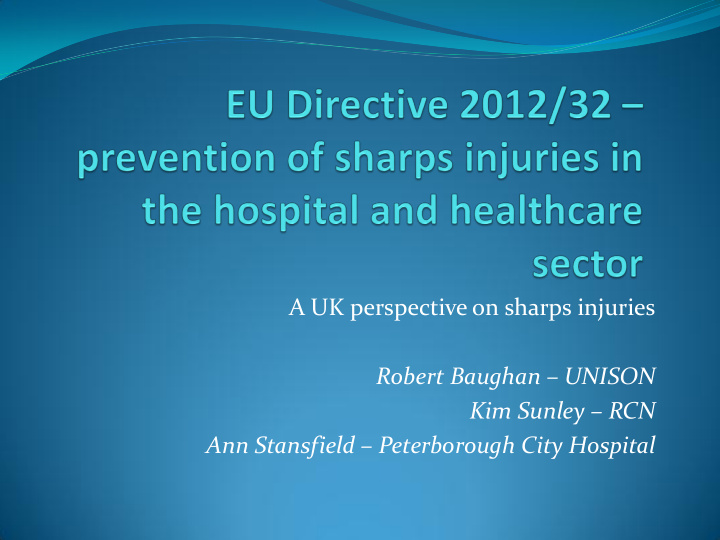



A UK perspective on sharps injuries Robert Baughan – UNISON Kim Sunley – RCN Ann Stansfield – Peterborough City Hospital
Contents Sharps injuries the picture in the UK Stakeholders and social partners Work of regulator Case Study Transposition of the Directive into domestic law Concerns and future challenges Key messages
Sharps injuries in the UK • Estimated 100, 000 sharps injuries in UK per annum (1) • Significant exposure surveillance system (HPA/HPS) ‘Eye of the Needle’ since 1997 (2) – 20 cases of Hepatitis C sero-conversions all percutaneous exposures – 5 HIV cases – Nurses and doctors/dentists main occupational groups BUT ancillary staff make up around 3% of reports – Most occurring in wards and operating theatres – Most injuries occurring after the procedure – Since 2002, 34% of healthcare workers exposed to HIV- infected source patients who start HIV PEP commenced it within one hour of their exposure; and 89% within 24 hours 1 Patterson and Elder (2005) Safer Sharps Evaluation Report 2 Health Protection Agency (2012) Eye of the Needle Report
Stakeholders and social partners Safer Needles Network Set up over 11 years ago Aim to prevent needlestick injuries Key stakeholders invited to attend from trade unions, professional bodies, employer representatives, health and safety regulator, national procurement, industry, national surveillance centre (HPA), litigation authority Lobbying, raising awareness, guidance and joint positions
Stakeholders and social partners Partnership for Occupational Safety and Health in Healthcare (POSHH) Sub group of wider negotiating body on national terms and conditions of NHS (health care staff). Bi-partite group with trade union and employer representatives The purpose of POSHH is to raise standards of occupational health and safety in the healthcare organisations and to promote best practice across both the NHS and the independent sector
Partnership for Occupational Safety and Health in Healthcare • Occupational health and safety standards • Joint guidance on sharps injuries • Series of workshops in 2009/10 to raise awareness of framework agreement • Representatives speaking at forums on the directive e.g. Infection control conference, occupational health nurses • Engagement with regulator • Joint response to the consultation on draft domestic laws
Partnership for Occupational Safety and Health in Healthcare
Work of UK health and safety regulator (HSE) 2011 Systematic review of efficacy of sharps safety devices “evidence that their use can reduce the incidence of injuries to healthcare workers, when combined with appropriate training and safe working practices” (1) Targeted inspection activity Comprehensive website of resources Prosecution of trust (1) HSL (2012) an evaluation of the efficacy of safer sharps devices
HSE Inspection Activity • 22 public sector health care organisations 2010/11 – 16 had a specific policy – 10 clear corporate strategic aims and objectives to prevent and reduce the risks – 6 had staff at all levels demonstrating a good understanding of their roles and responsibilities – In 4, safety representatives were not consulted – Risk assessments generally generic – Training patchy – Safer devices were used in 18 – Lack of monitoring – Only half carried out some form of audit and review HSE (2011) Management and prevention of sharps injuries: Inspection of NHS Trusts/Boards
Peterborough City Hospital Acute Hospital 600 Beds 3500 Staff Average of 200 sharps injuries per year over the past 5 years 4 high risk sharps injuries in financial year 2012/13 reported to the Health & Safety Executive (HSE) HSE Visit in May 2012
Action Taken HSE Suggested we speed up implementation of safety devices Evaluation to Identify main causes of injuries: Disposal into Sharps Bins Hypodermic Needles - use and disposal Insulin Pen Needles - disposal New intake of Doctors
Action Taken Evaluated and moved to a safer Sharps Bin (Sharpsmart) Following evaluation across the Trust – rollout of new safety devices to replace: hypodermic needles insulin pen needles New post in Trust to follow up and investigate all needlestick incidents Additional training for junior doctors Sharps Safety Group will continue to Monitor the situation
Transposition of the Directive – where are we? (1) • UK Regulator - Health and Safety Executive/Health and Safety Executive Northern Ireland • Consultation on transposition in November 2012 • TU response and joint social partners response • Stand alone regulations: Health and Safety (Sharp Instruments in Healthcare) Regulations 2013
Transposition of the Directive – where are we? (2) • Limited to what not already covered in existing EU Directives e.g. Biological agents and framework directive • Laid before parliament in April • Guidance from regulator to support organisations implement regulations 6 weeks before they become law
Trade Union concerns Scope Recapping Worker involvement Guidance/Approved Code of Practice Reporting
Risks and Future Challenges • Under reporting of injuries • Cost pressures on health sector • Increased number of health care providers • Scope of the Regulations – who is covered? • Government’s position on health and safety laws and European Union • Lack of proactive inspections by regulators • Media perceptions of health and safety • Staff safety = patient safety
Key Messages • Jointly agreed at EU level • Need to promote the cost benefits from implementing sharps regulations – as well as legal and moral case • Organisational commitment to staff health and safety ‘what’s good for staff is good for patients’ • Need to continue partnership working on this agenda at a local level as well as national and European. Engagement of safety reps • Role of regulator and importance of reporting injuries
Recommend
More recommend